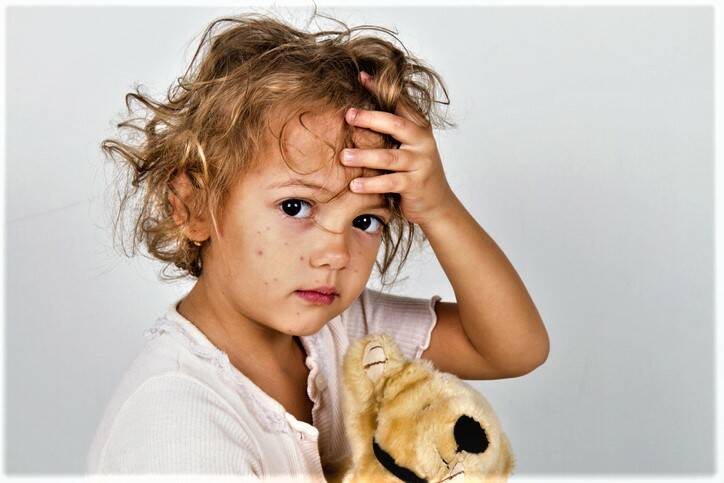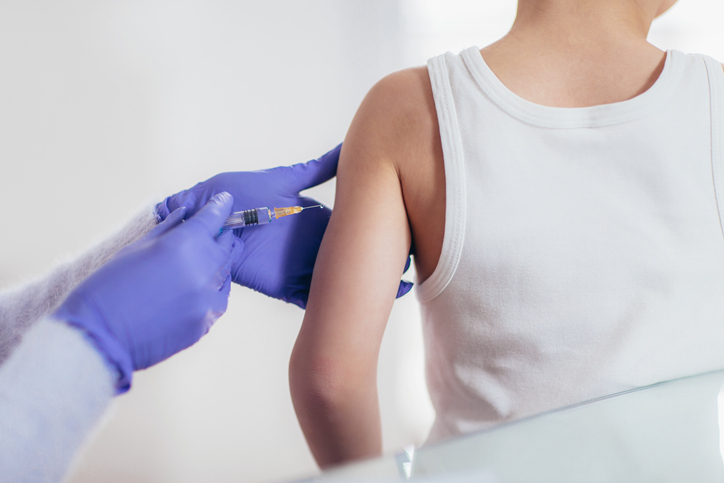Measles: Why do they arise and how do they manifest themselves? How to distinguish them from chickenpox?

Measles is one of the most serious diseases in children. It is a viral disease characterised by risky complications.
Most common symptoms
- Malaise
- Apathy
- Abdominal Pain
- Headache
- Joint Pain
- Limb pain
- Muscle Pain
- Sensitivity to light
- Fever
- Increased body temperature
- Nausea
- Diarrhoea
- Rash
- Indigestion
- Full nose
- Eye irritation
- Buds
- Dry cough
- Muscle weakness
- Fatigue
- Reddened skin
- Redness of the conjunctivae
- Winterreise
- Confusion
- Accelerated heart rate
- Increased watery eye
Characteristics
It is a highly contagious infectious disease characterized by aggressive infection, like the flu.
Measles is classified as an exanthemous disease. This means that one of the symptoms is a skin rash. This symptom is one of the important diagnostic data.
The Latin name is morbilli - it is the diminutive form of "morbus", i.e. disease.
The causative agent of the disease is...
...an RNA virus from the family Paramyxoviridae, genus Morbillivirus. It has only one antigenic type. It creates long-term immunity after overcoming the disease.
The source of the disease is...
...an infected person.
Measles is spread...
...by the airborne route as an infection by droplet transmission. Coughing or sneezing, sometimes contaminated objects or direct contact, facilitate the spread of the virus.
Viruses enter the body through...
...the mucous membranes of the mouth or nose and airways, as well as the conjunctiva, i.e. the tissue lining the eyelids.
Presumed infectivity, also called contagiousness, is very high. It is said that out of 100 people, 99 will develop the disease. The highest infectivity rate is reported at the prodromal stage.
The prodromal stage is the period of occurrence of the first signs and complications lasting until about the 3rd day of the exanthema stage. Consequently, the rate of contagion decreases.
What is the incubation period for measles?
The incubation period, i.e. the time from infection to the first symptoms, is approximately 9 to 12 days. After the second stage, it is 2 weeks.
According to reports, it takes 10 days until the onset of the catarrhal stage and 14 days until the onset of the rash.
Is it possible to assume a seasonal occurrence in measles?
Yes.
The most common outbreaks occur from winter to spring.
Measles has two stages
The catarrhal and the exanthem stages.
Table: information on the phases of measles
| Catarrhal phase | Exanthem phase |
| Also called the prodromal phase | The skin rash phase |
| It starts after the incubation period | It starts with the second rise of body temperature and a rash |
| After an incubation period of about 3-4 days | The rash starts on the face |
| General complications due to the flu | It progresses to the entire body |
| The spread of the disease takes place 4 days before the discovery of the first rash and 4 days after its discovery | |
The risk of further complications
It is also known that the virus mainly infects cells of the immune and nervous systems - it is lymphotropic and neurotropic.
The disease is serious due to a risk of complications. In this respect, measles is especially dangerous for children under three years of age and adults.
Common complications include:
- lung inflammation - pneumonia
- laryngitis
- encephalitis - inflammation of the brain
- bacterial superinfection
- inflammation of the mucous membranes that line the sinuses - sinusitis
- otitis
- bronchopneumonia
- subacute sclerosing panencephalitis - is a late complication
Causes
Another way of entering the body is the conjunctiva. Subsequently, the viruses enter the lymph nodes and the blood.
Outbreaks occur in almost 99% of susceptible individuals and in people without having been vaccinated.
Measles is a highly contagious infectious disease.
Children are the most at risk. However, measles can break out at any age.
Newborns and toddlers of vaccinated mothers are protected up to 6 months of age as well as the children of mothers who have had measles in the past. Antibodies pass through the uterus.
According to statistics, up to 50,000 people a year had been affected before the introduction of vaccinations in 1969.
Globally, especially in developing countries, measles is still a common cause of infant mortality, mainly due to complications.
Symptoms
Later, around day 14, i.e. 3-4 days after the prodromal stage, the exanthem stage begins.
Table: symptoms during each stage
| Catarrhal stage | Symptoms |
| Lasts 3 - 4 days | elevated body temperature |
| General symptoms, as in a viral disease | rhinitis |
| cough, mostly dry, may turn into a barking cough, as in laryngitis | |
| inflammation - conjuctivis | |
Koplik's spots - gray spots on a reddish background on the mucous membrane of the oral cavity
| |
| photophobia | |
| diarrhea may be associated | |
| generalised lymphadenopathy | |
| loss of appetite | |
| fatigue and pain throughout the body | |
| reduction in body temperature | |
| Exanthem stage | it starts with a second sharp rise in body temperature - possible fever |
| It starts after about the 4th day of the catarrhal stage | maculopapular exanthem - or rash
|
| The exanthem stage is approximately 6 to 8 days long |
typical appearance of skin rash:
|
| the rash is dark red and can spread into larger areas | |
| has a characteristic description - facies morbillosa | |
| The skin manifestations are the result of the spread of the infection and the virus in the blood | |
| Koplik's spots in the mouth disappear at the onset of the exanthem stage | |
| |
| In the case of an uncomplicated course, the disease lasts for a total of about 10-14 days | |
| Skin rashes turn pale, signs of peeling or flaky skin | |
| The total time to complete recovery is approximately 2 weeks | |
The risk is mainly the occurrence of complications:
| |
| Recovery creates lasting immunity | |

There are two specific forms of measles:
- abortive measles (mitigating measles)- measles with a moderate course
- at lower antibody levels
- in children after 6 months of age
- in people with delayed vaccination
- in case of vaccination, when a lower dose of antibodies was administered
- foudroyant measles
- in weakened immunity
- rapid course and short incubation period
- persistent fever to hyperpyrexia, ie body temperature above 40 °C
- mucosal bleeding
- high risk of death
Diagnostics

Hence, laboratory evidence of the measles virus is important. Blood tests, blood count, liver tests and serology will ned to be done. During a serological examination, IgM and IgG will be tested for. RT-PCR provides direct evidence.
Nasopharyngeal swab and cultivation are done as well.
The following is considered for a diagnosis:
- Clinical criteria
- fever
- maculopapular rash
- cough or rhinitis, or redness of the conjunctiva
- Laboratory criteria - at least one parameter met
- positive IgM
- virus isolation
- evidence of RT-PCR-negative
- elevated IgG in two samples
- Epidemiological criterium
- the presence of an epidemic - or persons-to-person transfer
The classification comes next:
- likely - clinical criteria are met
- probable - clinical criteria are met and the presence of an epidemiological link
- confirmed - the person has not been vaccinated and meets the clinical and laboratory criteria
Course
Symptoms of viral disease usually appear after the 10th day of the incubation period, like the flu. This catarrhal stage is characterized by an increase in body temperature, fever, runny nose and dry cough.
In addition...
Measles present with characteristic pale spots on a red background that appear on the mucous membrane of the oral cavity and hard palate.
After 4 days, the disease progresses to the second exanthem stage.
The rash begins with a second sharp rise in body temperature.
Reddish papules form behind the ears and on the nape. They spread to the face, chest and limbs. There may be some redness.
This condition lasts for about 4 days. The rash gradually disappears. The rash fades and the skin becomes flaky.
In total, the disease can last for 14 days, and the time until it is completely cured also takes 2 weeks. In about every 5th case, the course may be complicated.
Vaccination as the only way to prevention
Vaccination - active immunisation is the only effective form of prevention.
After 2 doses:around 99% of people will be protected against measles and rubellaaround 88% of people will be protected against mumps
The UK Immunisation Schedule is well worth visiting.
In the UK, the first dose of the MMR vaccine is administered at the age of 12 to 13 months. The vaccine contains live attenuated weakened measles viruses - morbilli, parotitis - mumps and rubella (German measles), also called the MMR vaccine.
In the UK, the second dose is administered as a booster at the age of 3 years and 4 months.
It is important to know that these weakened viruses are not a source of the disease.
The vaccine does not cause an outbreak. Its role is to stimulate the immune system to make antibodies. Following revaccination, an immunological memory is established.
By the 12th day after vaccination, a person may experience a physiological post-vaccination reaction - also referred to as post-vaccination syndrome.
Accompanied symptoms are:
- increase in body temperature
- throat infection
- redness of the conjunctiva
- mild rash on the face or chest - in about 7% of vaccinated individuals
- in some cases, swollen lymph nodes
- joint pain
- febrile convulsions during fever in young children
The issues arise only in vaccinated persons and are not transmissible, they just gradually disappear.
Non-vaccinated individuals should avoid infected individuals or get vaccinated after contact. Another option is to administer human immunoglobulin G to immunocompromised people.
Pregnancy and measles
Protection during pregnancy is important, as the disease could harm both the pregnant woman and the fetus. The highest level of risk is during the first trimester.
German measles can cause cleft lip, deafness, heart problems, and mental disabilities. In extreme cases, there is a risk of miscarriage. The sooner a pregnant woman gets measles during pregnancy, the higher the risk of fetal damage, premature birth or miscarriage.
Vaccination is contraindicated during pregnancy. It is not recommended to get pregnant for three months after vaccination.
Measles or chickenpox?
Both diseases are highly infectious and typical in children. Also, they are characterized by initial flu-like issues and skin rash. However, these are not the same diseases.
Table: Measles or smallpox?
| Symptom | Measles | Chickenpox |
| Body temperature | Increase in body temperature to fever 38 °C - 40 °C The second sharp rise in temperature with rashes | Temperature elevation during an outbreak of rashes |
| Pink eye | Typical symptom | No |
| Spots in the mouth | Yes - typical Gray on a red background | No |
| Rash | At onset, behind the ears and on the nape | Blister outbreaks on the body |
| Stuffy nose | Yes | No |
| Cough | Dry or barking cough | No |
For more information on the differences, see the article Measles or chickenpox? This is how you will know the difference.
How it is treated: Measles
Measles treatment: medication? Isolation and lifestyle interventions
Show moreMeasles is treated by
Other names
Interesting resources
Related










